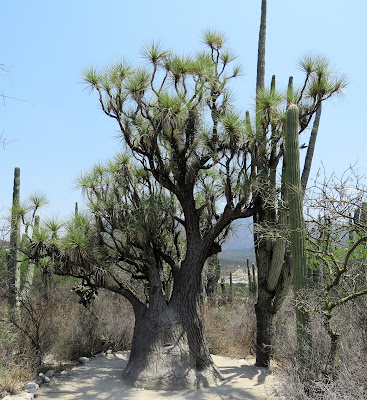Big foot no match for zealous collectors
Despite its common names this is of course neither a palm, a pachyderm nor a pony. Its closest relatives include other succulents such as Dasylirion and Draceana, but also things like Aspidistra, Liriope (Mondo Grass) and Ruscus (Butcher's Broom).
Elephant's Foot or Ponytail Palm are common names for Beaucarnea, a genus native to Mexico and Central America, which as you know I passed through briefly in April. This will be the last of my extended series based on a few days in Cuba and less in Mexico, but I'm sure to return later to a few of the plants I discovered on my transient travels.
There are 13 species, with Beaucarnea recurvata the best known in Australia: indeed I bought one a few weeks ago to give to my mother for Mother's Day (as an indirect memento of my visit to Mexico). In its native habitat in Mexico, however, this species is, like most Beaucarnea species, at risk of extinction. The two facts are possibly related - over collecting for horticulture is a threat to many odd and unusual plants, particularly this genus.
At Jardín Botánico Helia Bravo Hollis, near Tehuacán in Mexico, Beaucarnea gracilis was the local species, with some specimens reputedly 500 years old. It is only found in the Tehuacán Valley and although the population is in generally good shape recruitment of new plants is low. Here's another of the possible quincentenarians, and its depiction in the botanic garden logo.
At the botanic garden associated with the National Autonomous University of Mexico in Mexico City, there were at least three species grown: Beaucarnea gracilis, Beaucarnea stricta and Beaucarnea hiriartiae. This is the latter one.
All species of Beaucarnea have leaves adapted to living in arid areas, with tough narrow leaves covered in wax and sunken pores (stomata). Some species have 'grooved leaves' to further protect the pores for regulating the exchange of gases and the loss of water.
When you grow it (mum), don't over water. That swollen base is where it stores water in the arid areas of Mexico. It's happy in a smallish pot and let it dry out between waterings. In winter you can forget watering entirely. These two youngsters are in the university botanic garden.
There are quite a few plants that look a bit like the Elephant's Foot, although generally without the foot. Common in the area of Mexico I visited, and in Australian homes, is the Yucca, which is not entirely unrelated but is in a different part of the very large Asparagaceae family (yes which does include your household asparagus). This is another image from the university.
Adiós, y gracias por las suculentas!







Comments